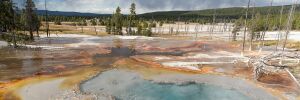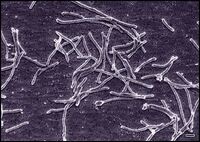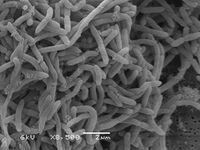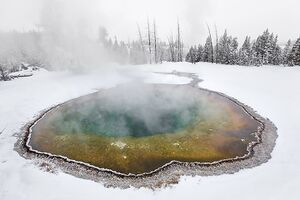Microbial organisms in Yellowstone
Introduction
The microbial community found in Yellowstone national park is extremely diverse and extensive. The wide variety of microorganisms lead to extensive and ongoing research in the park. Factors attributing to the diversity of microorganisms include the park’s range in environments with varieties of temperature, pH, and Hydrogen Sulfide levels[1]. The areas of accumulating interests include the hot springs, Thermopools, and geysers located in Yellowstone National Park. These areas sparked the interest of many researchers because there are organisms not only living, but thriving in extreme conditions such as superheated environments and underwater in anaerobic environments [2] .Some of the interesting microorganisms include, but are not limited to; Thermophilic Bacteria, Thermus Aquaticus, Caldicellulosiruptor obsidiansis, Cyanobacteria, algae, mushrooms, fungi (ex. Curvularia protuberata), and Sulfolobus Acidocaldarius[3][4]. The Thermophilic bacteria that were first discovered in the hot springs of Yellowstone increased research on this type of bacteria and led to many more new discoveries on how these extremophiles were able to survive. Because Thermophilic bacteria are able to exist in extreme temperature and pH ranges, they became very popular organisms to study, especially because they have a variety of mechanisms that are not found in other cells that have been previously studied [1].

How Thermophiles Survive in Extreme Heat
A large quantity of organisms residing in the superheated environments are classified as Thermophiles. These organisms fall under this classification because the name means heat lover (Thermo: Heat, Phile: Lover) and the environments they are mostly found in are superheated environments[3]. Most Thermophiles fall under the bacteria and archaea domains however, there are a small number of eukaryotes that can be classified as thermophiles [5]. Thermophilic bacteria can thrive in a range of water temperatures, some environments inhabited by thermophiles even surpass the boiling point of water [6]. These bacteria have become a hot topic of research and study due to the adaptability of their metabolic processes and the process of their life functions.The reason they can survive in such conditions can be attributed to many factore, a few being that Thermophiles have adapted their proteins and DNA to be more stable and enzymes to function better in hotter environments. These adaptations are called thermo-adapted genes by scientists, and have been a recurring topic studied and researched for years [5]. The determination and classification of the adaptations also leads to the study of how and why they are accumulated and passed on. Adaptation can happen by natural selection or random mutation, the ways the adaptations are passed on and spread through a colony of archaea or bacteria can be determined by studying the history of a specific gene. One method of the transfer of adapted genes is Horizontal Gene Transfer. Horizontal Gene transfer is the passing of a gene from parent to offspring. For example, one gene that is passed from parent to offspring in Thermophilic Archaea is the gene coding for the Reverse gyrase[5]. The reverse gyrase topoisomerase helps with the DNA denaturation, it induces supercoiling of the double stranded DNA in order to increase the temperature in which the DNA can exist without denaturing or melting[5]. This adaptation is one of the factors of thermophiles that allow them to live in such extreme conditions and environments. The thermophilic genome contains a wide variety of adaptations and mutations, yet is smaller than most prokaryotic genomes [5].This is due to gene loss. The archaea and bacteria that live in these extreme environments often discard genes that they are no longer in need of or serve no function[5]. This allows the DNA to become more compact and less likely to denature at higher temperatures. Protein stability is also a large factor when it comes to being able to survive at high temperatures. In order for the protein to be more stable, the machinery that builds the protein must also be able to withstand intense heat. It is actually more important that the protein assembling machinery is able to withstand high temperatures. This is because if a protein were to denature or not be able to function properly due to the heat it could just be rebuilt. This is not the case for the protein building machinery, for these vital functioning parts of the cell there is no replacement [7]. Thermophilic cells also adapt to functioning at higher temperatures by adjusting the expression of their genes and how fast the enzymes work in processes such as protein synthesis, gene replication, and gene expression. For example in some organisms certain gene expression is temperature dependent, meaning that only certain segments of the DNA or gene are expressed at certain temperatures. This also means that higher temperatures can unlock expression of genes or operons [5]. These adaptations, among others, are what separate thermophilic and extremophilic organisms from the rest. Their capability to survive and thrive under extreme stress and conditions are what keep scientists researching and finding new ways that these organisms adapt to their environments and evolve to become more complex.
Thermophilic Organisms found in Yellowstone National Park
The many types of organisms found in yellowstone hold a vast array of bacteria, archaea, and eukaryotes. Most of these organisms found in the hot springs or geysers of the park are Thermophiles. A few thermophiles found and studied in the park include; Thermus aquaticus,Caldicellulosiruptor obsidiansis,Cyanobacteria,Sulfolobus acidocaldarius,and Curvularia protuberata [4].

Thermus aquaticus:
This microorganism was discovered in 1966 in the lower geyser basin of Yellowstone national park[4]. Thermus aquaticus was an extremely important discovery because it led scientists to find Taq polymerase[8] This polymerase was named after the organism it was found in, T- Thermal AQ- Aquaticus. Taq Polymerase was groundbreaking in the science world because it now allows scientists to perform Polymerase Chain Reaction cycles, or PCR for short. PCR is the process by which small segments of DNA are copied over and over again for amplification[9]. Taq polymerase is heat tolerant and works at a fast rate enabling scientists to perform this process quickly and efficiently[8].

Caldicellulosiruptor obsidiansis:
This microorganism was isolated from an obsidian pool in Yellowstone national park([10]. Caldicellulosiruptor obsidiansis performs anaerobic functions such as fermentation and uses many carbohydrates including glucose, maltose, arabinose, fructose, lactose, mannose, sucrose, galactose and xylose for energy production and metabolism [3].
Cyanobacteria:
These bacteria are photosynthetic organisms that can also be found in extreme environments however, when the sun sets cyanobacteria begin nitrogen fixation[11]. Cyanobacteria also add to the array of colors found in Yellowstone national park [3]. These bacteria form “mats” along the sides and floor of water basins and hot pools around the park.
Sulfolobus acidocaldarius:
Sulfolobus are thermoacidophilic bacteria that are found in Yellowstone national park. These bacteria are unique because they can survive in both a high and low pH environment [12] They use sulfide gas escaping from the earth and convert it into sulfuric acid[3]. The production of sulfuric acid can cause erosion.
Curvularia protuberata:
This fungus causes an increase in grass and weed growth in areas close to superthermal pools or vents where plants would not normally grow. It is thought that the fungus sets off a trigger to activate a stress response in the plant consistently so that the plane survives in stressful conditions[13]
Morning Glory

The Morning Glory pool is a hot spring found in Yellowstone national park that has an interesting story. It was named in the 1880s for its remarkable likeness to its namesake flower because at the opening of the park the hot spring was a bright blue color, but over time the color of the pool drastically changed[14]. This change in color has many attributes, one being the fact that many tourists and visitors threw trash, coins, and other things into the pool. The effect of this caused buildup along the sides of the pool which altered water circulation and affected the microorganism life within the hot spring. Although the current colors of the pool are captivating, it does not mean that there are good effects on the environment or the organisms residing in the water. The color changes indicated that there was a change in temperature or pH and this change could have killed some of the microbial life found in the hot spring. Some of the thermophiles found in the Morning Glory pool are actually distinguishable by color. Colorless and yellow thermophiles grow in the hottest water while Orange, brown, and green thermophiles grow in cooler waters[14]. This exemplifies how microbial ecosystems can be changed by slight environmental adjustments such as temperature and pH.
Larger Effect
The study of microorganisms is relevant today because there is ongoing research that advances scientific knowledge of life and how it works. One relevant piece of information found by Thomas Brock is aiding the world now in many ways, one being in the fight against COVID-19[15]. Brock’s discovery of Taq polymerase changed the scientific world and how we process and analyze DNA. Taq polymerase made sequencing the human genome, genetic tests, and characterizing entire microbial communities across the globe possible[16]. The use of Taq polymerase today ranges from hospitals to crime scenes to highschool and college labs. The genetic testing and sequencing of both the human and viral genome assist doctors and researchers today in figuring out what Covid-19 is and how to stop it from spreading.
Conclusion
The microorganism population in Yellowstone National Park cover an array of different microbes. Thermophiles being the most abundant in the various hot springs and geysers dotted around the park. These thermophiles are also accompanied by many other microorganisms around the park that are essential for the life and function of the environment. Microbes play a large role in keeping the balance of the ecosystem as well as replenishing the environment with vital nutrients and molecules that may have been used previously. The importance of microbes reaches far beyond just the ecosystem in which they live. Microorganisms found in extreme habitats have led to many scientific developments. The most famous discovery being Thomas Brock's findings resulting in the isolation and use of Taq Polymerase. There are also many other vital discoveries that have advanced both the scientific research field and the medical development field. Overall Yellowstone National Park is rich with microbes of all kinds, ones that have been and are currently being researched, and maybe still some left to discover.
References
- ↑ 1.0 1.1 Pandey, A., Dhakar, K., Sharma, A. et al. Thermophilic bacteria that tolerate a wide temperature and pH range colonize the Soldhar (95 °C) and Ringigad (80 °C) hot springs of Uttarakhand, India. Ann Microbiol 65, 809–816 (2015). https://doi.org/10.1007/s13213-014-0921-0
- ↑ Life in Extreme Heat. https://www.nps.gov/yell/learn/nature/life-in-extreme-heat.htm
- ↑ 3.0 3.1 3.2 3.3 3.4 https://blog.microbiologics.com/microorganisms-of-yellowstone-national-park/
- ↑ 4.0 4.1 4.2 https://www.nps.gov/yell/learn/nature/thermophilic-eukarya.htm
- ↑ 5.0 5.1 5.2 5.3 5.4 5.5 5.6 Wang Q, Cen Z, and Zhao J, The Survival Mechanisms of Thermophiles at High Temperatures: An Angle of Omics https://journals.physiology.org/doi/full/10.1152/physiol.00066.2013#
- ↑ https://www.nps.gov/yell/learn/nature/thermophilic-bacteria.htm
- ↑ Brock, Thomas D. “Life at High Temperatures.” Science 158, no. 3804 (1967): 1012–19. http://www.jstor.org/stable/1722957.
- ↑ 8.0 8.1 Barr, Camile. Thermus aquaticus. https://www.montananaturalist.org/blog-post/thermus-aquaticus/
- ↑ https://info.gbiosciences.com/blog/why-taq-polymerase-is-the-preferred-enzyme-for-polymerase-chain-reaction-pcr
- ↑ Hamilton-Brehm SD, Mosher JJ, Vishnivetskaya T, Podar M, Carroll S, Allman S, Phelps TJ, Keller M, Elkins JG. Caldicellulosiruptor obsidiansis sp. nov., an anaerobic, extremely thermophilic, cellulolytic bacterium isolated from Obsidian Pool, Yellowstone National Park. Appl Environ Microbiol. 2010 Feb https://pubmed.ncbi.nlm.nih.gov/20023107/
- ↑ Wright. Cyanobacteria living in hot springs flip a metabolic switch at night, study finds Organism in Yellowstone quits photosynthesis after sundown and begins to fix nitrogen https://news.stanford.edu/news/2006/february8/yellowstone-020806.html
- ↑ Julian Quehenberger, Lu Shen, Sonja-Verena Albers, Bettina Siebers and Oliver Spadiut.Sulfolobus – A Potential Key Organism in Future Biotechnology.https://www.frontiersin.org/articles/10.3389/fmicb.2017.02474/full
- ↑ Stevens. Yellowstone plant reveals secret for tolerating high temperatures.https://www.montana.edu/news/629/yellowstone-plant-reveals-secret-for-tolerating-high-temperatures
- ↑ 14.0 14.1 https://www.nps.gov/places/000/morning-glory-pool.htm
- ↑ https://daily.jstor.org/how-yellowstone-extremophile-bacteria-helped-with-covid-19-testing/
- ↑ https://www.usgs.gov/observatories/yvo/news/how-thermophilic-bacterium-yellowstone-hot-spring-helping-fight-against
Authored for BIOL 238 Microbiology, taught by Joan Slonczewski, 2022, Kenyon College
